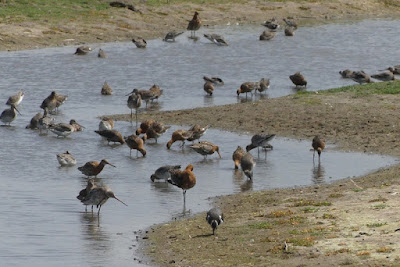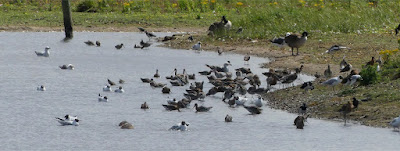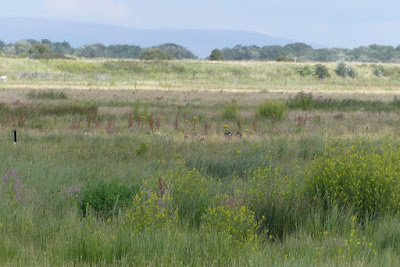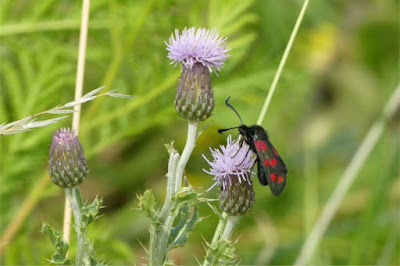 |
| Black-tailed godwits, lapwings and dunlin |
It threatened to be a dry but cloudy day, appreciably cooler than last week but still objectively warm. I woke to a high pollen count alert and thought to myself how lightly I'd gotten off it this year. Then I remembered that I haven't been properly able to breathe through my nose for a week. I decided to head for the seaside.
The sun shone in Manchester. Black clouds brooded over Wigan. It was bright and sunny in Southport. It was cloudy and sunny and windy at Marshside. It was one of them days.
 |
| From Marshside Road |
Marshside Road was fizzing with spadgers and house martins. The marshes either side of the road were dry green grass and looked deserted until Canada geese popped their heads up on sentry-go. Goldfinches and greenfinches twittered and sang and a whitethroat sang from one of the few remaining bits of hawthorn hedgerow. For once the land drains were bone dry until I got to the end of the road where they're dug a lot deeper.
 |
| Stonechat |
The stonechats silently checked me out as I passed by.
 |
| Stonechat |
 |
| Stonechat |
 |
| Junction Pool |
Junction Pool was mostly dried mud, a few cattle loafed in what little damp remained. I looked round in case any waders or cattle egrets about but aside from a moorhen and a couple of starlings it was nothing doing.
 |
| Marshside from the seat at the junction with Marshside Road |
Swallows buzzed the tops of the banks as I wandered over to Sandgrounders. A juvenile black-necked grebe had been reported here yesterday, I was hoping it might still be about, it would be a Merseyside tick for me and they're always nice to see. Failing that there should be some waders about given the dry state of the rest of the marsh.
 |
| Tufted duck |
There was a crowd of black-headed gulls and black-tailed godwits on the islands in the pool by Sandgrounders. A few Canada geese and herring gulls loafed on the banks with a cormorant and the inevitable great black-back. A few lesser black-backs and herring gulls were having a bath in one corner. Mallards, coots and tufted ducks drifted about on the water. Most of the adult godwits were still in foxy breeding plumage though a few were starting to show signs of their Winter greys. The juveniles were in greys and a few young birds still had relatively short bills which made me look twice to make sure of what I was seeing
 |
| Black-tailed godwits, mallards, tufted ducks and black-headed gulls |
It was just as busy at Sandgrounders. It would have been easy to miss the half a dozen ruffs in the crowds if they didn't have such motley plumage. There weren't a lot of lapwings and just the one shelduck, I couldn't find any avocets. A couple of pied wagtails skittered about. Something which might have been a snipe lurked behind a far bank. A dunlin flew in and joined the godwits by the hide.
 |
| Black-tailed godwits, ruff (centre) and lapwings |
 |
| Herring gull, black-headed gulls, black-tailed godwits and Canada geese |
 |
| Black-tailed godwits, lapwings and dunlin |
 |
| Black-tailed godwits |
Something — I know not what — put up the waders. They billowed round in a panic. Two snipe shot off into the long grass over by Polly's Pool. Eventually everything settled back down, it was not as if there were very many other places to go.
 |
| Canada goose (left) and greylags (centre) |
 |
| Black-tailed godwits, black-headed gulls and shelduck |
 |
| Ruffs and tufted duck |
When I'd walked in there were three gents sitting along the side windows staring intently down the drain that runs the length of this side of the reserve. Apparently the black-necked grebe was still about but had gone into the reeds at one side. It was a while before one sighed and said: "It's back out again!" I looked over. I could see coots and mallards and a fishing cormorant and a few more tufties… no grebe of any persuasion, I wasn't at the right angle. Eventually it drifted far enough out of the reeds — just — so I could see it. For a moment. If I'm being honest, my initial identification of the bird was by the time it spent underwater. The second time it bobbed back up I got a better look at it, all in grey scale and with a dark cap. It was too far away to be hoping for details like the red eye to be visible. But I'd seen it.
A common sandpiper flew in to join the medley of waders then flew over to join the pied wagtails fossicking about in the grass at the top of the bank. I was hoping for a green sandpiper or a wood sandpiper but it wasn't happening.
I checked the time, I'd best bob on if I wanted to miss the Oasis concert traffic in Manchester. A flock of about a hundred starlings descended onto the bank next to the hide and disappeared into the long grass. On the way out I had a look to see if I could remember where the bee orchids were last time. I'd forgotten they were so small this year, I almost missed the still green seed heads nestling in the dewberries.
 |
| Common blue |
Walking down Marshside Road the wind seemed to have put off any butterflies on the roadside verges, despite the overpowering scents of ragwort, tansy and goldenrod. Walking back was a different story with meadow browns and common blues fluttering in and out of the grass and feeding on the shorter stemmed flowers. The burnet moths were made of sterner stuff and clung onto the thistles like limpets.
 |
| Seven-spot burnet moth |
I got the train back to Manchester easily enough and made the connection home surprisingly easily too. The train was ram-packed solid and I had to stand putting my weight on an ankle that had been behaving itself all day. it didn't take the gloss off a good day's birdwatching.



















No comments:
Post a Comment